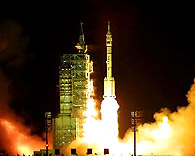 "Shenzhou III," China's third unmanned spacecraft that can carry out all the functions of a manned craft, was launched successfully Monday night, symbolizing another milestone in China's space science and technology.
"Shenzhou III," China's third unmanned spacecraft that can carry out all the functions of a manned craft, was launched successfully Monday night, symbolizing another milestone in China's space science and technology.
President Jiang Zemin watched the launch of spacecraft Monday night at the launch center in northwest China's Gansu Province.
The spacecraft was boosted by the "Long March II F" carrier rocket into a pre-set orbit at 22:15 Monday in Jiuquan.
At the launch site, Jiang extended his congratulations to scientists and technologists, as well as servicemen of the People's Liberation Army (PLA).
Space experts said that "Shenzhou III" was "technically suitable for astronauts." A set of metabolic simulation apparatus, human physical monitoring sensors and dummy astronauts have been installed aboard the spaceship.
During the test launch, space scientists for the first time tested the escape system, which could save the lives of astronauts.
After watching the lift-off, Jiang said the successful launch showed the Chinese people's spirit of constantly striving to become stronger.
Jiang said the CPC Central Committee decided to carry out the manned space program a decade ago.
The Chinese-made "Long March" carrier rockets and "Shenzhou" spacecraft represent the country's scientific and technological achievements, he said.
China has established a spacecraft application system, a state-of-the-art space launch site, a spacecraft monitoring and controlling network and a spacecraft landing system, as well as a group of astronauts, Jiang said.
Jiang encouraged the scientists and technologists to upgrade the country's scientific and technological level and improve national might.
During the craft's outer-space travel, a series of scientific and technological experiments are planned in "Shenzhou III," which consists of an orbital module, re-entry module, propulsion section and access section.
Scientists with the Chinese Academy of Sciences (CAS) have planned experiments on life sciences, space materials, space astronomy, space physics and microgravity research.
After separation from the re-entry module, the orbital module will continue circling the Earth for several months.
Officers in charge of the China Manned Space Program said Shenzhou's flight was being tracked and controlled from the Beijing Aerospace Direction and Control Center, Xi'an Satellite Monitoring Center and a fleet of four monitoring vessels, which have been deployed in the Atlantic, Pacific and Indian oceans.
Monday's launch followed the second test flight of an unmanned spacecraft 14 months ago. The country's maiden unmanned space flight took place in November 1999.
At around 10:25 pm, "Shenzhou III" detached itself from the launch vehicle. A technician then clicked his computer mouse to send a command to the spacecraft, immediately guiding it to fly to its pre-set orbit.
A chain of other tele-commands were sent from the command center to steer the flight and operate the spacecraft.
At 10:33 pm, three-dimensional images and data displayed on a huge computer screen at the Beijing center indicated that the spacecraft had precisely entered its pre-set orbit.
Tracking networks on land and at sea reported to the command center that the rocket and spacecraft were responding well to commands, eliciting thunderous applause from scientists and control staff at the center.
The spaceship is expected to circle the earth once every 90 minutes. It will fly in space for a couple of days before landing.
Monday's launch constituted part of China's ambitious manned mission project, which aims to finally construct a permanently-attended space station, said an official at the Beijing Aerospace Control Center.
(China Daily March 26, 2002)
